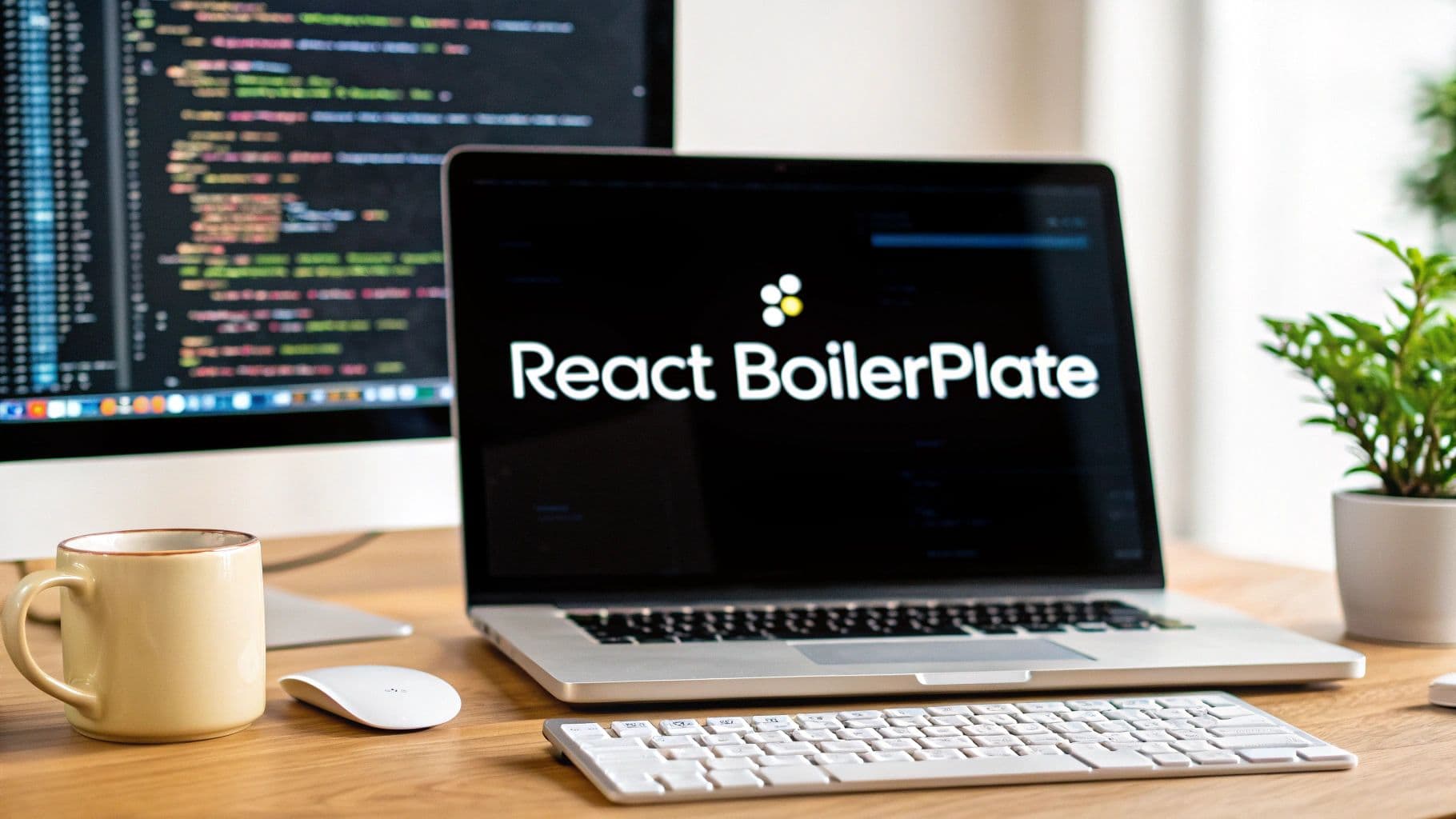react
boilerplate react js
javascript
web development
frontend
Top Boilerplate React JS Templates for 2025
Jumpstart Your React Project with the Perfect Boilerplate
Starting a new React project can be time-consuming. Choosing the right boilerplate React JS setup eliminates tedious configuration and lets you focus on building features. This list presents seven top boilerplate options for 2025, comparing their strengths and weaknesses to help you choose the best fit for your needs. Quickly compare Create React App, Next.js, Vite, React Boilerplate, Gatsby, React Redux Starter Kit, and Chakra UI React Starters and get coding faster.
1. Create React App
When discussing boilerplate React.js solutions, Create React App (CRA) consistently tops the list. Developed and maintained by Facebook, CRA provides a zero-configuration setup, allowing developers to dive straight into building React applications without getting bogged down in complex build configurations. It handles the intricacies of webpack and Babel behind the scenes, offering a streamlined command-line interface for creating, developing, testing, and building your projects. This makes it an ideal starting point for both beginners learning React and experienced developers looking to quickly prototype ideas.
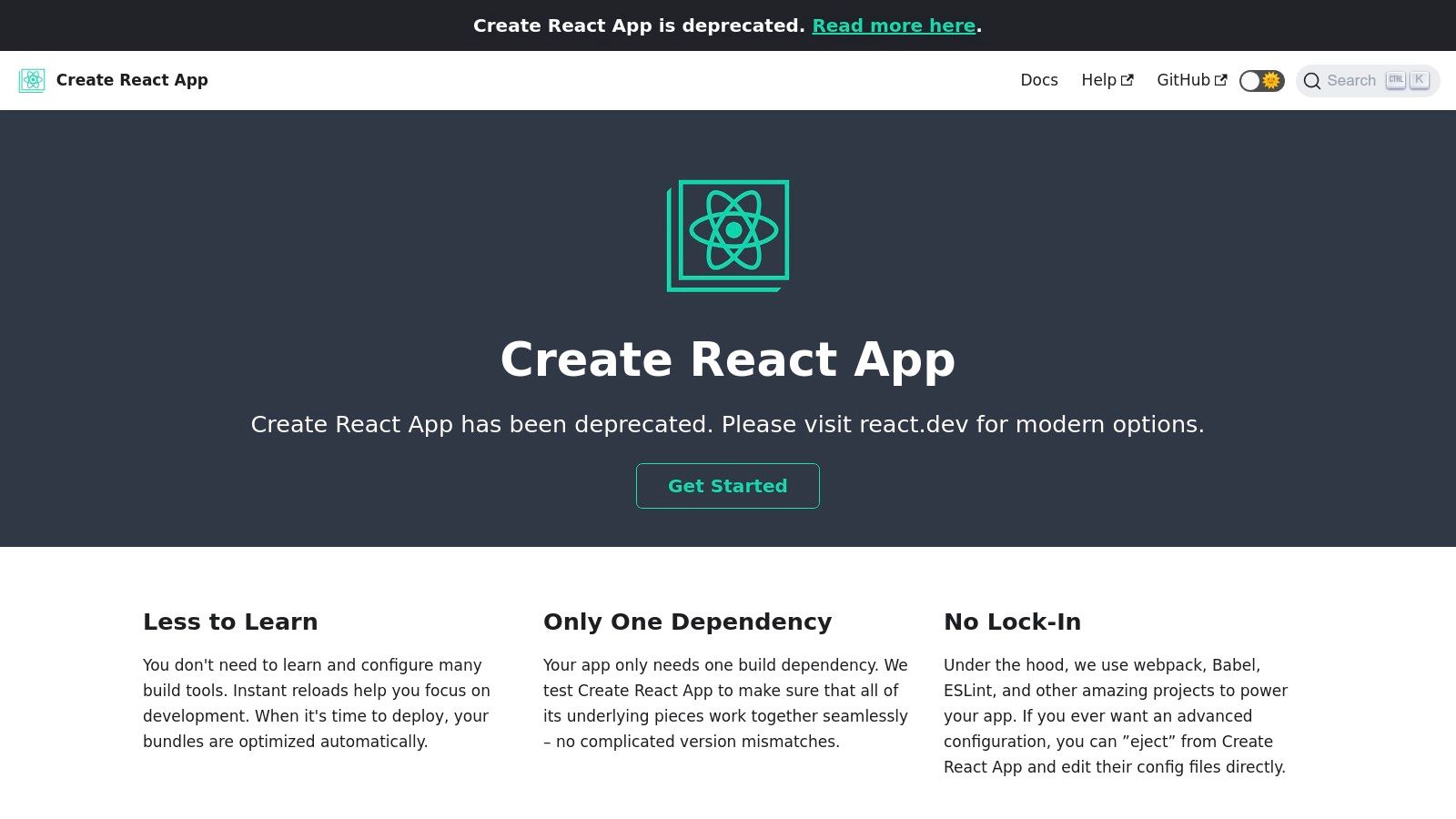
CRA's key strength lies in its simplicity. With a single command, you can scaffold a new project complete with everything you need: ES6+ support, JSX compilation, integrated testing with Jest, and optimized production builds. Hot module replacement ensures a smooth development experience by automatically refreshing your browser when you make changes to your code. This rapid feedback loop significantly speeds up development. Furthermore, built-in support for CSS modules and TypeScript allows developers to write maintainable and scalable code. For those exploring next-generation JavaScript features or requiring strongly typed code, this built-in support is invaluable.
For independent developers, hobbyists, and startup founders, CRA's ease of use and minimal setup time are invaluable. It allows them to focus on building their core product instead of wrestling with build configurations. Similarly, freelance agencies and consultants can leverage CRA to quickly deliver client projects, while product managers and technical leads can use it to prototype new features and test concepts. Even AI enthusiasts and prototypers working with React for machine learning visualizations can benefit from CRA's simplified workflow.
Features:
- Zero-configuration setup (no need to configure webpack or Babel)
- Built-in support for ES6+ features, JSX, TypeScript, and CSS Modules
- Hot module replacement during development
- Optimized production builds with code splitting
- Integrated testing environment with Jest
Pros:
- Official React tool with excellent documentation and community support
- Extremely simple to get started with a single command
- Regular updates and maintenance by Facebook
- Wide adoption making it easy to find solutions to common problems
Cons:
- Limited customization of the build configuration unless you "eject"
- Ejecting makes future updates difficult to integrate
- Larger bundle sizes compared to some alternatives (though this is often negligible for smaller projects)
- Not optimized for server-side rendering (SSR) out of the box, requiring additional configuration
Website: https://create-react-app.dev/
Implementation Tip: To create a new project, simply open your terminal and run npx create-react-app my-app. This will create a new directory named "my-app" containing a basic React project. Then, navigate to the new directory using cd my-app and start the development server with npm start.
CRA earns its place at the top of this list because it provides the most accessible entry point into the React ecosystem. While alternative boilerplates offer more flexibility and control, CRA excels in its simplicity, making it the perfect starting point for a wide range of developers and projects, especially when rapid prototyping and ease of use are paramount. If you're looking to build a React application quickly without delving into complex configurations, Create React App is the ideal choice.
2. Next.js
Next.js is a powerful React framework developed by Vercel that elevates boilerplate React JS development to the next level. While it started as a tool for simplifying setup, it has matured into a comprehensive framework offering server-side rendering (SSR), static site generation (SSG), and a host of other features crucial for building high-performance, scalable React applications. Unlike Create React App (CRA) which focuses primarily on client-side rendering, Next.js provides a more structured and opinionated approach, handling routing, API integration, and performance optimization out-of-the-box, making it an excellent choice for both simple and complex projects.
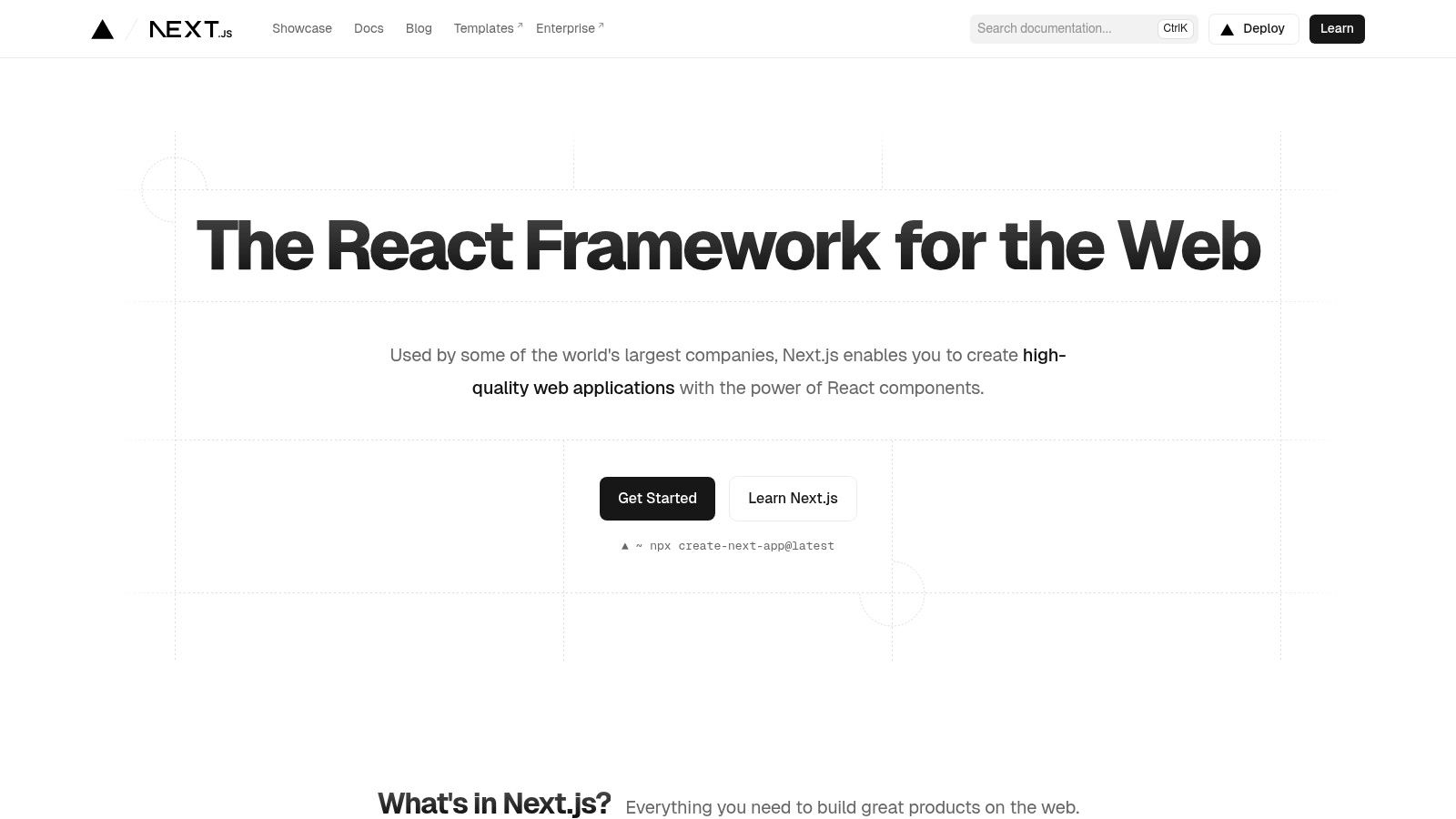
Next.js shines in scenarios where SEO and initial load times are paramount. For instance, if you're building an e-commerce site or a blog, SSG allows you to pre-render pages at build time, resulting in faster loading speeds for users and improved search engine visibility. For applications requiring real-time data, SSR enables dynamic content generation on the server, delivering personalized experiences while retaining SEO benefits. Its file-system based routing simplifies navigation management, automatically generating routes based on your project's file structure. Moreover, Next.js’s built-in API routes empower developers to create backend functionality directly within their projects, eliminating the need for separate backend services for simpler applications. Features like built-in CSS and Sass support and automatic code splitting further enhance the developer experience and contribute to optimized performance. You can learn more about Next.js and explore starter templates to kickstart your projects.
For startup founders, freelance agencies, and product managers, Next.js offers a compelling balance between rapid development and robust features. It empowers teams to build highly performant applications with improved SEO and streamlined workflows, crucial for achieving business goals. Even for hobbyists and AI prototypers, Next.js can be a valuable asset, especially when experimenting with server-side functionalities and seeking enhanced performance.
Features:
- Server-side rendering (SSR) and static site generation (SSG)
- File-system based routing with dynamic routes
- API routes for building backend functionality
- Built-in CSS and Sass support
- Automatic code splitting and optimized performance
Pros:
- Excellent performance with SSR and SSG capabilities
- Great developer experience with hot reloading and error reporting
- Zero configuration with sensible defaults
- Strong enterprise adoption and community support
Cons:
- More opinionated than plain React, requiring a specific file structure
- Steeper learning curve for beginners compared to CRA
- Some advanced customizations can be complex
- Tightly integrated with Vercel deployment (though not required)
Website: https://nextjs.org/
Next.js deserves its place on this list because it effectively addresses the limitations of basic boilerplate React JS by providing a robust and comprehensive framework for building production-ready applications. While it introduces a learning curve, the benefits in terms of performance, SEO, and developer experience significantly outweigh the initial investment for many projects, especially those aiming for scale and performance. Its opinionated structure, while potentially a hurdle for complete beginners, ultimately promotes maintainability and best practices in the long run, making it a solid choice for serious React development.
3. Vite
Vite has quickly become a popular choice for boilerplate React.js projects, offering a compelling alternative to older tools like Create React App (CRA) and webpack. It prioritizes developer experience with an extremely fast development server and instant hot module replacement (HMR), making the process of building React applications significantly more efficient. This speed boost comes from Vite's use of native ES modules in the browser during development, eliminating the need for bundling before serving. For production builds, it leverages Rollup, ensuring optimized and performant output. If you're looking for a boilerplate for your React.js project that emphasizes speed and a modern development environment, Vite is an excellent option.
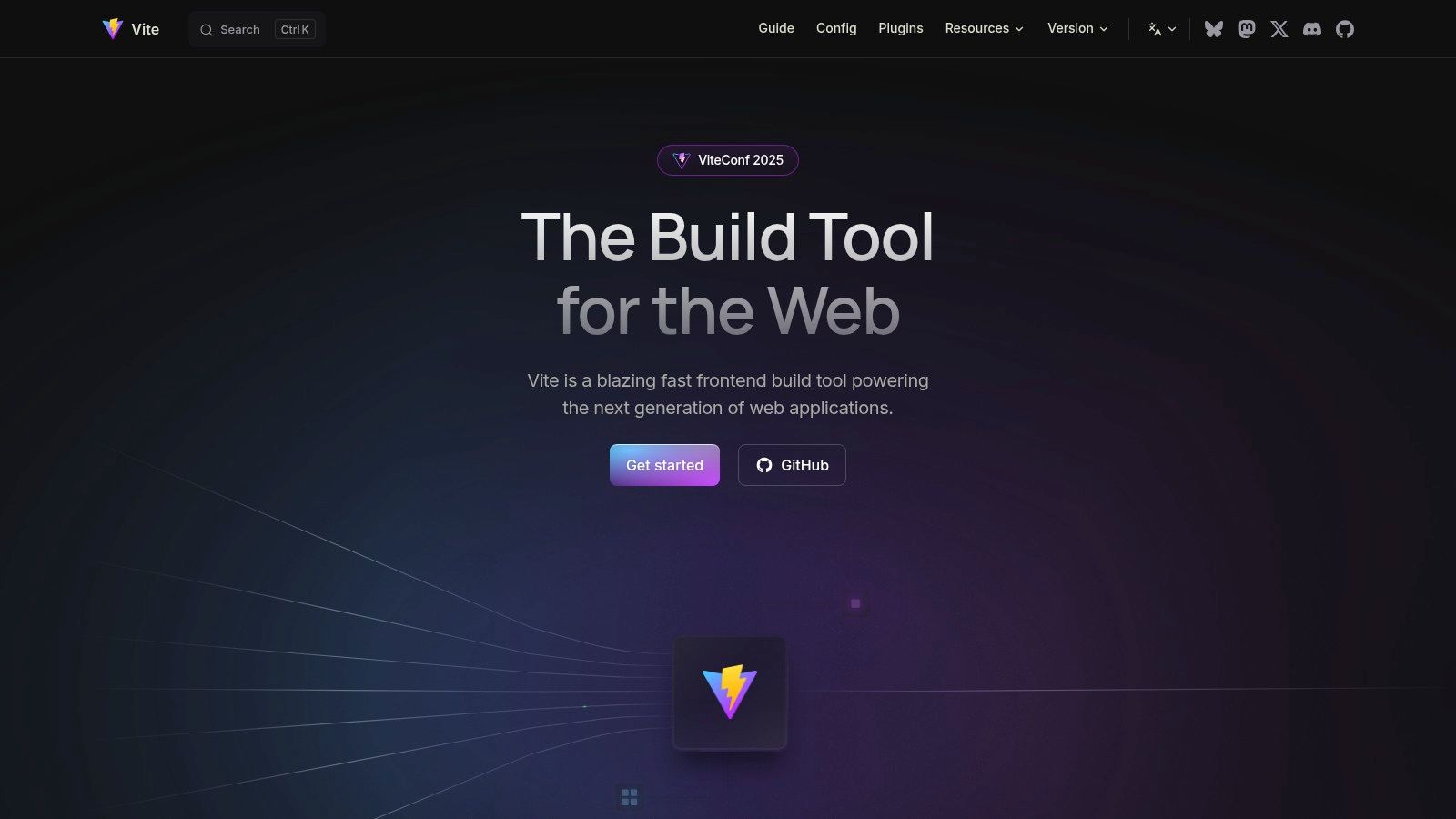
Vite shines in several key areas. Its pre-configured templates for React (and other frameworks like Vue and Svelte) allow you to quickly scaffold a new project with minimal configuration. Out-of-the-box TypeScript support caters to developers who prefer static typing. These features combined make Vite an ideal boilerplate React.js starting point for various users, from independent developers and hobbyists prototyping new ideas to startup founders rapidly building MVPs, freelance agencies needing efficient workflows, and even product managers and technical leads exploring new technologies. AI enthusiasts and prototypers will also appreciate the rapid iteration cycles enabled by Vite's speed.
One of the most significant advantages of Vite compared to tools like CRA and custom webpack setups is its significantly faster development server startup and near-instantaneous HMR. This means less waiting and more coding, leading to increased productivity. Imagine making a change to your React component and seeing it reflected in the browser almost instantly – that's the Vite experience. This speed is a game-changer, especially for larger projects where rebuild times can be substantial with other tools.
Features:
- Extremely fast development server using native ES modules
- Instant hot module replacement (HMR)
- Pre-configured templates for React (and other frameworks)
- Out-of-the-box TypeScript support
- Optimized production builds with Rollup
- Simple and flexible configuration
Pros:
- Much faster development server startup compared to webpack-based tools
- Near-instantaneous hot module replacement
- Simple and flexible configuration
- Modern approach leveraging latest browser capabilities
Cons:
- Relatively newer tool with a smaller (but rapidly growing) ecosystem
- Some plugins from the webpack ecosystem may not be available
- Less mature than CRA or Next.js (though rapidly catching up)
- May require additional setup for some advanced features
Implementation/Setup Tips:
Getting started with Vite is straightforward. Use the following command to create a new React project using the Vite CLI:
npm init vite@latest my-react-project --template react
Replace my-react-project with your project's name. This command will scaffold a new React project with all the necessary dependencies and configurations. Then, navigate into the project directory and start the development server:
cd my-react-project npm install npm run dev
Website: https://vitejs.dev/
Vite offers a modern and efficient approach to building React applications. While it's a relatively newer tool, its incredible speed, simple configuration, and growing community make it a strong contender in the boilerplate React.js ecosystem, earning it a well-deserved spot on this list. If developer experience and rapid iteration are your priorities, Vite is definitely worth exploring.
4. React Boilerplate
React Boilerplate distinguishes itself as a powerful and opinionated boilerplate react js solution designed for scalability and offline-first functionality. It prioritizes performance and best practices, offering a robust architecture ideal for complex and large-scale React applications. This makes it a compelling choice for teams working on ambitious projects that demand high performance and maintainability. Unlike simpler boilerplates, React Boilerplate offers a comprehensive starting point packed with features ready for production.
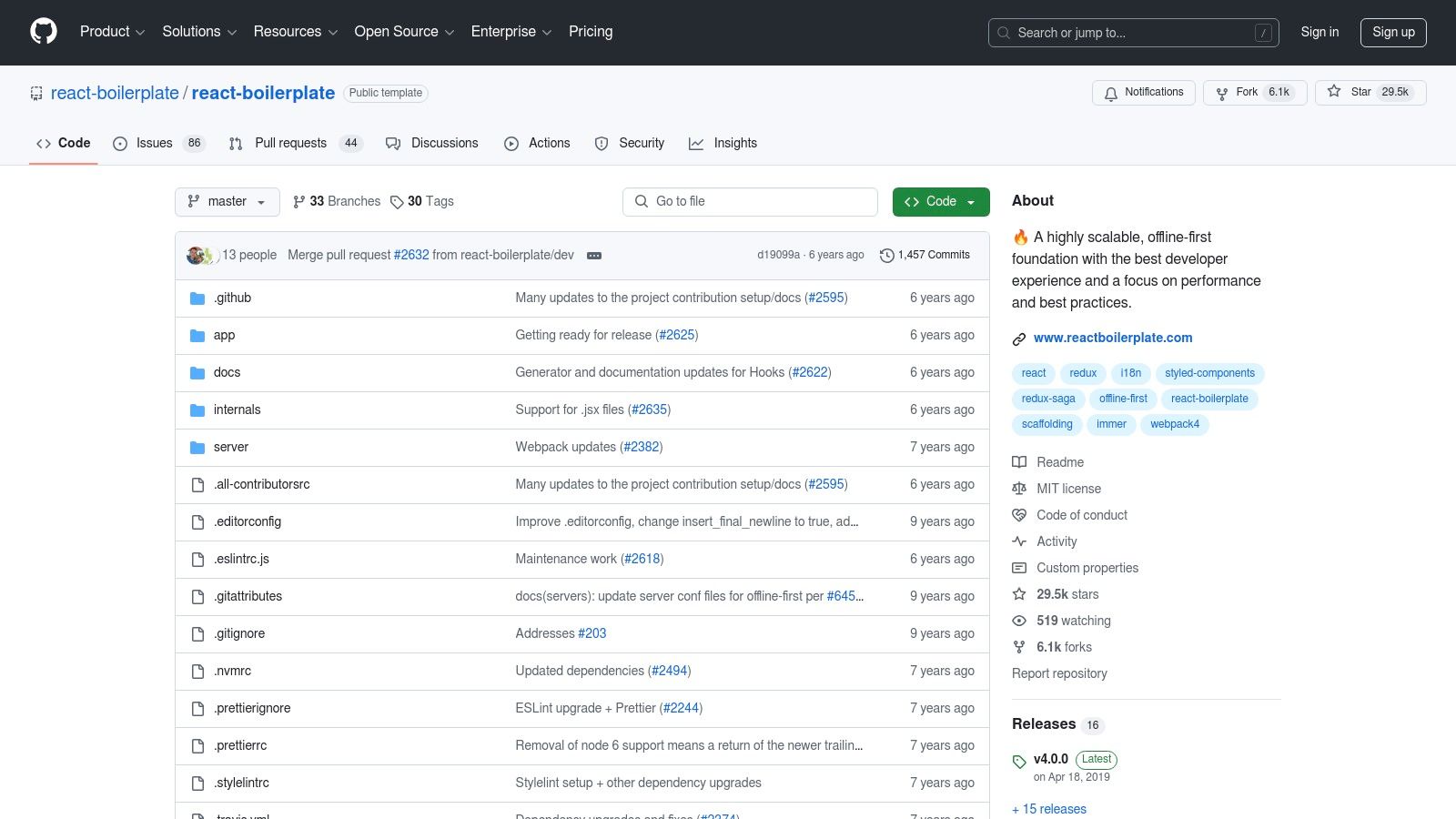
This boilerplate goes beyond basic setup by integrating essential tools and patterns for building production-ready apps. This includes a well-structured state management setup using Redux, ensuring predictable state updates and easier debugging. Its offline-first approach, powered by service workers, allows your application to function seamlessly even without an internet connection, enhancing user experience and reliability. Furthermore, React Boilerplate supports comprehensive internationalization, allowing you to easily adapt your application to different languages and regions. Advanced routing with react-router is included, making it easy to manage complex navigation within your application. Styling is handled with styled-components, a popular CSS-in-JS library, allowing for dynamic and maintainable styling. Learn more about React Boilerplate for a deeper understanding of its capabilities.
For developers building large-scale applications, React Boilerplate offers a significant advantage with its well-structured foundation and pre-configured features. Its comprehensive documentation on architecture decisions provides valuable insights into the reasoning behind the boilerplate’s design choices, making it easier for teams to understand and contribute to the codebase. The strong emphasis on performance and best practices ensures that your application is optimized for speed and efficiency from the start.
However, this robustness comes with trade-offs. React Boilerplate is more complex and opinionated than simpler alternatives like Create React App (CRA), which can present a steeper learning curve, especially for beginners. It might be overkill for smaller projects where a lighter-weight solution might suffice. Furthermore, while actively maintained by the community, its update frequency might be less compared to some other boilerplates. The project is open-source and freely available via its GitHub repository (https://github.com/react-boilerplate/react-boilerplate). Therefore, there are no licensing costs associated with using React Boilerplate.
To implement React Boilerplate, you can clone the repository from GitHub. The project provides clear instructions on how to set up and configure the boilerplate for your specific needs. Familiarity with Redux, styled-components, and service workers is beneficial for utilizing the boilerplate effectively. If you're tackling a complex, large-scale project and prioritize a structured, performance-focused foundation with numerous production-ready features, React Boilerplate offers a strong foundation. However, if you're working on a smaller project or are a beginner, consider the trade-offs in complexity and learning curve before adopting this boilerplate react js option.
5. Gatsby
Gatsby stands out as a powerful boilerplate option for React.js developers, particularly those focused on building high-performing websites and applications. It leverages the flexibility of React with the speed advantages of static site generation. This means Gatsby generates all your site's HTML during the build process, leading to significantly faster loading times for end-users. This framework is particularly well-suited for content-heavy projects such as blogs, e-commerce platforms, documentation sites, and landing pages that prioritize SEO and performance. Instead of fetching data on the client-side like traditional React apps, Gatsby uses GraphQL to query and collate data from various sources (CMSs, databases, APIs, Markdown files, etc.) during the build process. This results in pre-rendered static pages delivered quickly to users, boosting Core Web Vitals and SEO performance.
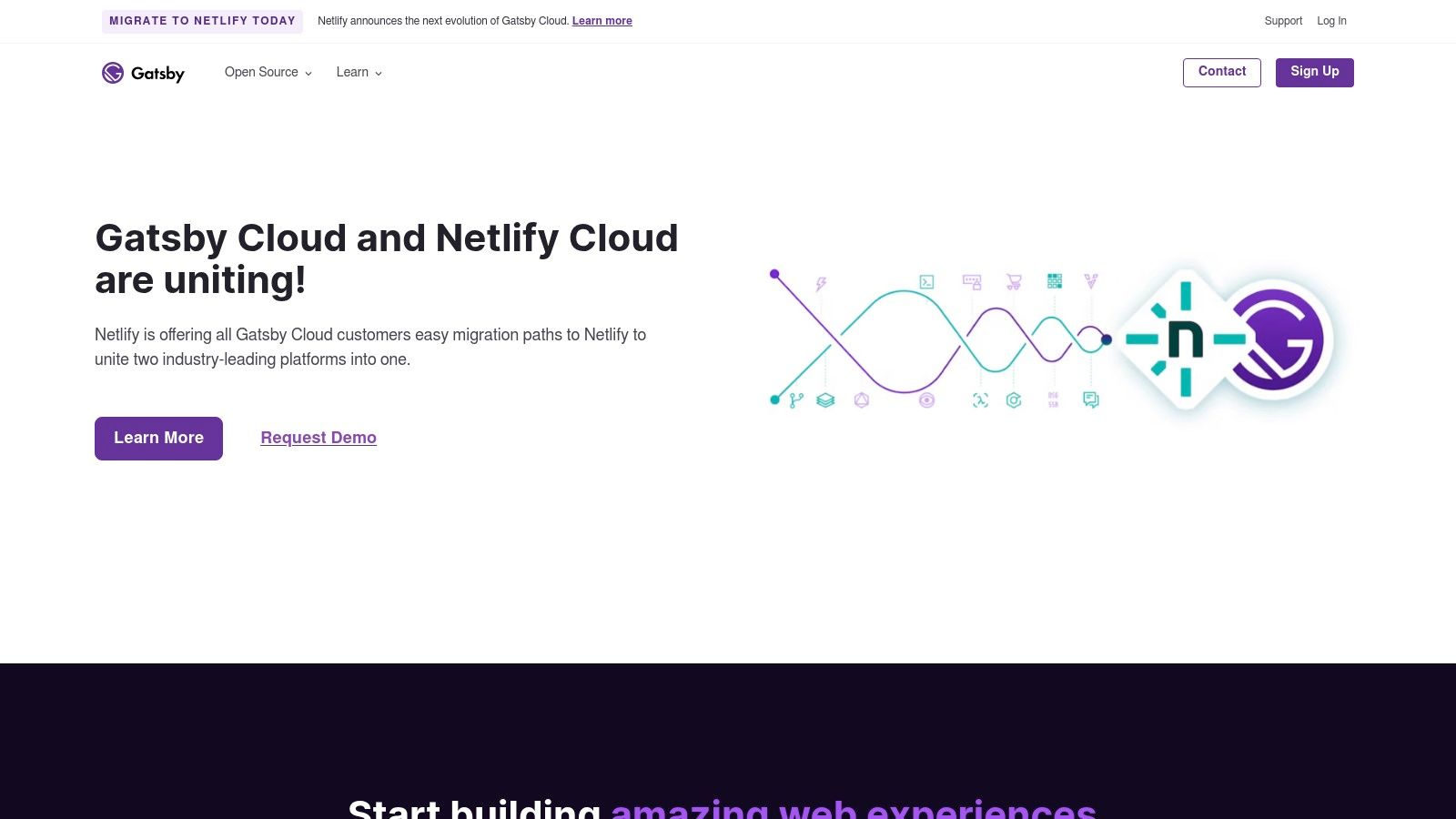
Gatsby shines in projects where content is a primary focus. Imagine building a blog with hundreds of articles. Using Gatsby, each article is pre-rendered into static HTML at build time. This means when a user clicks on an article, the server simply serves up the ready-to-go HTML, resulting in near-instantaneous loading. Compare this to a traditional React app where the browser would have to fetch the article data, then render the page, leading to a noticeable delay, especially on slower connections. This performance boost is a key reason why Gatsby deserves a spot on this list.
Features:
- Static site generation with React components: Build dynamic React applications that are rendered as static HTML at build time.
- GraphQL data layer: Query and integrate data from virtually any source into your application using the flexible GraphQL.
- Large plugin ecosystem: Extend Gatsby's functionality with numerous plugins for features like sitemaps, analytics, and CMS integration.
- Progressive web app (PWA) features built-in: Easily create PWAs offering offline capabilities and improved user experience.
- Image optimization and lazy loading: Improve site performance with built-in image optimization and lazy loading capabilities.
Pros:
- Excellent performance: Pre-rendered static pages ensure lightning-fast loading times.
- Rich ecosystem: Benefit from a large community and a vast library of plugins and starters.
- Great for SEO: Static HTML generation improves crawlability and indexability by search engines.
- Unified data layer with GraphQL: Simplifies data management and retrieval from diverse sources.
Cons:
- Build times can be slow for large sites: Generating thousands of static pages can take time, especially for large projects.
- GraphQL learning curve: Requires familiarity with GraphQL, which can be a barrier for new developers.
- Some dynamic features require additional setup: Implementing features like authentication and real-time updates requires integrating client-side JavaScript functionalities.
- Overkill for simple applications: For small applications with minimal content, simpler boilerplates might be more suitable.
Implementation/Setup Tips:
Getting started with Gatsby is straightforward thanks to the Gatsby CLI. Use npm install -g gatsby-cli to install it globally. Then, gatsby new my-gatsby-site will scaffold a new project based on a starter (e.g., gatsby new my-blog https://github.com/gatsbyjs/gatsby-starter-blog). Gatsby’s documentation and community resources offer ample guidance for customizing and deploying your Gatsby site.
Website: https://www.gatsbyjs.com/
Gatsby is a free and open-source framework. While Gatsby itself is free, costs might arise from hosting your generated static site and potentially from using third-party services integrated via plugins.
In comparison to other boilerplates like Create React App, Gatsby prioritizes performance and SEO through static site generation. Create React App is ideal for dynamic single-page applications (SPAs) while Gatsby excels in building fast, content-rich websites. For developers targeting high performance and SEO, Gatsby offers a compelling advantage. For simple applications, Create React App's simplicity might be preferable.
6. React Redux Starter Kit
For developers seeking a robust and well-structured foundation for their React applications, the React Redux Starter Kit presents a compelling option. This boilerplate prioritizes developer experience, modern tooling, and best practices, making it particularly suitable for building scalable applications leveraging Redux for state management. It distinguishes itself from simpler boilerplates through its inclusion of hot reloading, comprehensive testing utilities powered by Jest and Enzyme, and a powerful build system built upon webpack. This makes it ideal for projects anticipated to grow in complexity.
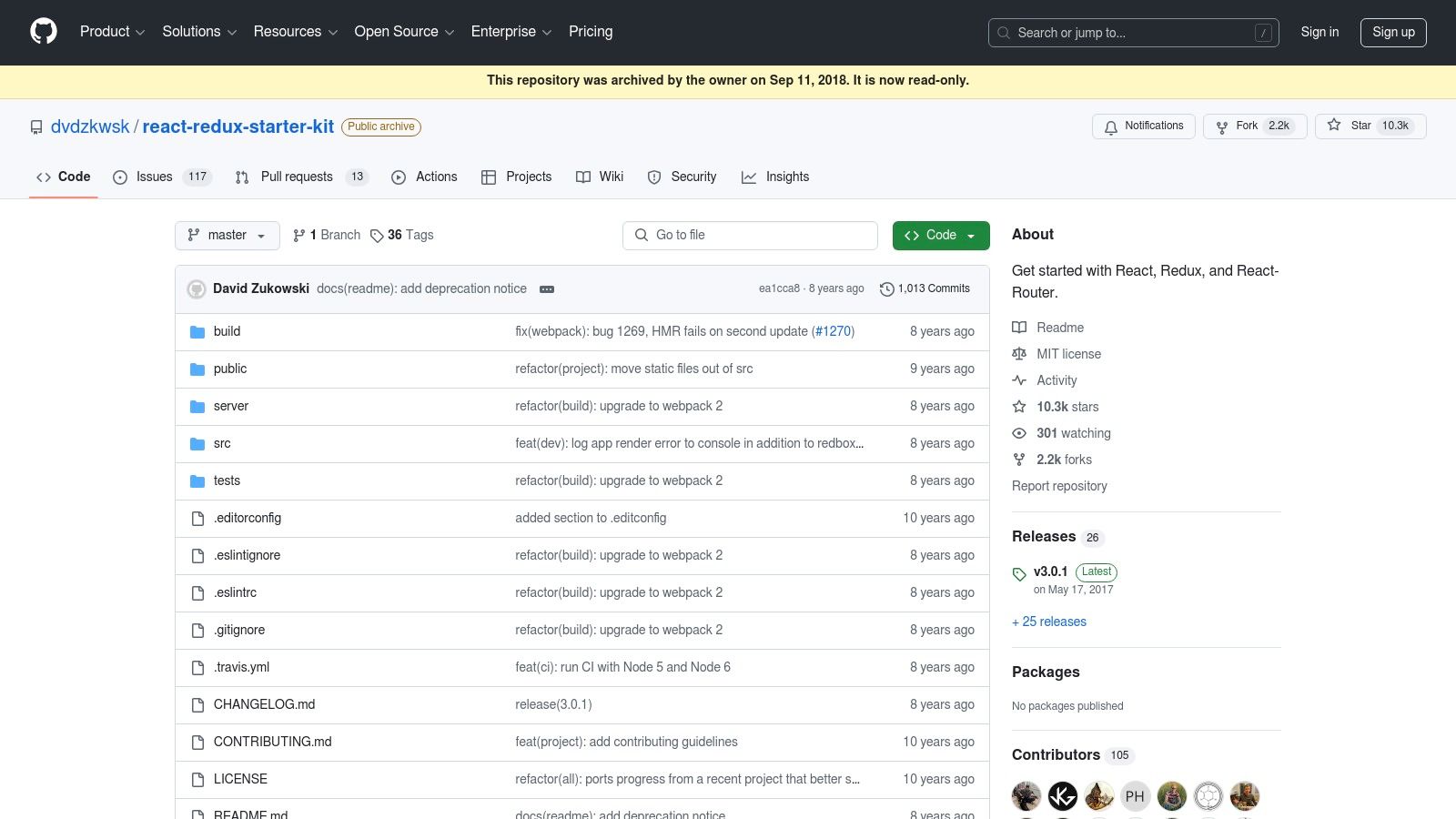
The starter kit shines in its structured approach to project organization, offering a clear and maintainable architecture for mid to large-scale applications. Features like hot reloading significantly boost developer productivity by allowing instant updates to the application during development without requiring full page reloads. The inclusion of Redux integration, complete with developer tools and adherence to best practices, simplifies state management, a crucial aspect of complex React applications. The integrated testing setup with Jest and Enzyme promotes test-driven development and helps ensure code quality from the outset.
Compared to more minimal boilerplate react js options like Create React App (CRA), React Redux Starter Kit offers more advanced features and a more opinionated structure. While CRA excels in its simplicity and ease of setup, the Starter Kit caters to projects where scalability and maintainability are paramount. However, it's worth noting that the Starter Kit is not as actively maintained as some other options and some dependencies might become outdated. It's also more complex than minimal starters, and its documentation is less extensive than officially maintained tools.
If you're considering different business models for your application, you might find some inspiration in resources like Learn more about React Redux Starter Kit which explores various SaaS ideas.
Features:
- Redux integration with developer tools and best practices
- Well-structured project organization
- Hot reloading with React Hot Loader
- Testing setup with Jest and Enzyme
- Comprehensive webpack configuration
Pros:
- Well-structured for mid to large-scale applications
- Good balance of opinions and flexibility
- Focus on developer experience with hot reloading
- Includes sensible defaults for state management
Cons:
- Not as actively maintained as some other options
- Some included dependencies may become outdated
- More complex than minimal starters like CRA
- Less documentation compared to official tools
Website: https://github.com/davezuko/react-redux-starter-kit
This boilerplate react js solution provides a strong foundation for building complex, scalable React applications. While it requires a slightly steeper learning curve than more basic options, the benefits of its structured approach and rich feature set become increasingly apparent as your project grows. It's particularly well-suited for teams and individuals who prioritize maintainability, testability, and developer experience.
7. Chakra UI React Starters
If you're looking for a way to kickstart your React project with a polished and accessible UI, Chakra UI React Starters deserve a spot in your boilerplate react js toolkit. These starters provide pre-built templates that combine the power of Chakra UI, a popular React component library, with various frameworks like Next.js, Gatsby, and Create React App. This allows you to focus on building the core functionality of your application rather than getting bogged down in styling and accessibility concerns from the outset. This is especially valuable for boilerplate react js projects where rapid prototyping and development are key.
Chakra UI React Starters are an excellent choice for several use cases:
- Rapid Prototyping: Quickly create visually appealing prototypes with pre-built components, allowing you to test and iterate on ideas efficiently. This is particularly beneficial for startup founders, entrepreneurs, and AI enthusiasts who need to get their ideas off the ground quickly.
- Accessible Web Applications: Chakra UI is built with accessibility in mind, following WAI-ARIA standards. This makes it easy to build applications that are usable by everyone, including users with disabilities. This is a key consideration for freelance agencies, consultants, and product managers building client-facing applications.
- Consistent Design Systems: Leverage Chakra UI's theming capabilities to maintain a consistent design language across your application. This streamlines development and ensures a professional, cohesive user experience.
- Component-Focused Development: Chakra UI promotes a component-based architecture, which enhances code reusability and maintainability, ultimately saving developers time and effort, a crucial factor for independent developers and hobbyists.
Here's a breakdown of the features and benefits:
Features:
- Pre-configured Chakra UI components and theming.
- Responsive design system built-in.
- Accessibility features following WAI-ARIA standards.
- Dark mode support out of the box.
- Various template options for different frameworks (Next.js, Create React App, Gatsby).
Pros:
- Beautiful, accessible UI components from the start: Jumpstart your project with a visually appealing and inclusive user interface.
- Consistent design system with theming capabilities: Easily maintain a unified design language across your application.
- Multiple template options for different project needs: Choose the starter that best suits your chosen framework and project complexity.
- Component-focused architecture promoting reusability: Build modular and maintainable code.
Cons:
- Tied to Chakra UI design system: While components are customizable, you're still working within the constraints of Chakra UI's design language.
- May require learning Chakra UI's specific patterns: There's a learning curve associated with any new library.
- Less focus on application architecture compared to some alternatives: These starters prioritize UI, so you may need to put more thought into the overall application structure.
- More opinionated about UI than some other starters: Chakra UI has a distinct style, which might not be suitable for every project.
Getting Started:
You can explore the various Chakra UI React starters and documentation on their official website: https://chakra-ui.com/getting-started
Chakra UI is open-source and free to use.
In comparison to other boilerplate react js options, Chakra UI React Starters distinguish themselves by prioritizing beautiful, accessible UI components right out of the box. While options like Create React App provide a basic foundation, Chakra UI adds a layer of pre-styled components and theming, which significantly speeds up the initial styling process. This makes it an excellent choice for developers who want to focus on functionality and quickly achieve a visually appealing and accessible interface. However, if you prefer complete control over your styling and are not a fan of opinionated libraries, exploring alternatives might be more beneficial.
Top 7 React Boilerplate Comparison
| Starter Kit | Core Features/Characteristics | User Experience/Quality ★★★★☆ | Value Proposition 💰 | Target Audience 👥 | Unique Selling Points ✨ |
|---|---|---|---|---|---|
| Create React App | Zero-config, ES6+, JSX, TypeScript, Jest testing | Simple to use, official support ★★★★☆ | Free, widely adopted 💰 | Beginners, small-medium apps 👥 | Zero configuration, official React boilerplate |
| Next.js | SSR, SSG, API routes, file-based routing, optimized performance | Robust, great DX, enterprise-grade ★★★★★ | Free, strong community 💰 | Enterprise, scalable apps 👥 | Server-side rendering, file-system routing, API routes |
| Vite | Lightning-fast dev server, native ES modules, TypeScript | Instant HMR, fast startup ★★★★☆ | Free, modern build tool 💰 | Modern devs wanting speed 👥 | Fast dev experience, simple config |
| React Boilerplate | Redux, offline-first, i18n, structured for large apps | High performance, production-ready ★★★★☆ | Free, complex but robust 💰 | Large-scale, production apps 👥 | Scalable architecture, offline support |
| Gatsby | Static site generation, GraphQL data layer, plugins | Fast static sites, SEO-friendly ★★★★☆ | Free, rich ecosystem 💰 | Content-heavy sites, SEO-focus 👥 | Static generation + GraphQL data fetching |
| React Redux Starter Kit | Redux with dev tools, hot reload, testing setup | Balanced, good DX ★★★☆☆ | Free, opinionated 💰 | Mid-large apps needing Redux 👥 | Well-structured Redux integration & tooling |
| Chakra UI React Starters | Chakra UI components, theming, accessibility, multiple templates | Beautiful UI, accessible, brandable ★★★☆☆ | Free, UI-focused 💰 | UI-focused projects, Chakra users 👥 | Accessible, responsive Chakra UI out-of-the-box |
Level Up Your React Development
Choosing the right boilerplate React JS foundation is crucial for efficient and effective development. From the simplicity of Create React App to the comprehensive features of Next.js and the performance boost of Vite, we've explored a range of tools catering to diverse needs. Remember, key takeaways include understanding the trade-offs between ease of use and customization, and the importance of considering factors like server-side rendering (SSR) and existing project requirements. For example, if your project has complex state management, leveraging a boilerplate like React Redux Starter Kit can save you valuable setup time. Similarly, if you’re aiming for a visually appealing application with minimal styling effort, Chakra UI React Starters can be a game-changer. Selecting the appropriate boilerplate React JS solution allows you to focus on building core features, not wrestling with configuration.
Your choice depends on your specific project goals. Smaller projects or those requiring rapid prototyping may benefit from the streamlined setup of Create React App or Vite. Larger applications or those needing SSR might find Next.js or Gatsby more suitable. Finally, if you're working with a team, the existing familiarity with specific technologies should also influence your decision.
For those looking to accelerate the development of AI-powered projects, consider leveraging a purpose-built solution. AnotherWrapper, a comprehensive AI starter kit built with Next.js, provides a robust boilerplate React JS foundation complete with pre-built components and integrations, enabling you to rapidly launch your micro SaaS ideas. Kickstart your next AI project and explore the power of a pre-configured, high-performance environment – visit AnotherWrapper today to learn more and begin building.
Fekri

